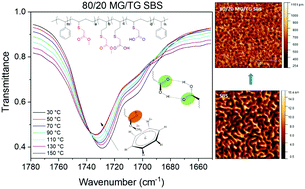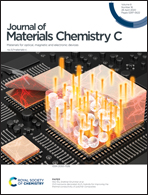Understanding the enhancement and temperature-dependency of the self-healing and electromechanical properties of dielectric elastomers containing mixed pendant polar groups†
Abstract
High permittivity self-healing dielectric elastomers have the potential to achieve long life, reusability, damage tolerance and enhanced energy density for energy harvesting devices and actuators. The self-healing performance of elastomers and usable temperature range can be affected by the chemical interactions present in the material. Self-healing thermoplastic elastomer styrene-butadiene-styrene (SBS) copolymers were prepared by introducing hydrogen bonding and electrostatic interactions through chemically grafting of polar groups to SBS: methyl thioglycolate (MG) and thioglycolic acid (TG). The mechanical properties were significantly affected by the strength of the hydrogen bonding network in the elastomers, whilst a high relative permittivity of εr ≈ 9.2 with a low loss of tan δ ≈ 0.01 was achieved. In addition, a disorder-to-order phase morphology transition was observed upon increasing the TG content due to the increased hydrogen-bonding network within SBS. At room temperature the self-healed 80/20 MG/TG-SBS exhibited a strain at break of 139% with a recovery ratio of 47.7%, and when healed at 80 °C for 3 hours exhibited an increased strain at break of 230% with a recovery ratio of 79%. Analysis of FTIR and 1H NMR indicated that the presence of a stronger hydrogen bonding network increased the thermal resistance of the elastomers. The temperature-dependency of the self-healing behaviour was interpreted as the combined effect of hydrogen bonding, electrostatic interactions and chain interdiffusion. This work provides an in-depth understanding of how to tune the electromechanical and self-healing properties of elastomers by tailoring the type and concentration of pendent polar groups. It indicates that intrinsic modification is critical for the development of next generation high performance dielectric elastomers for actuator or energy harvesting devices operating at elevated temperatures.



 Please wait while we load your content...
Please wait while we load your content...